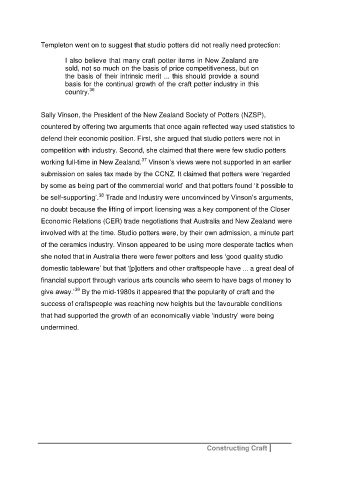Page 223 - Constructing Craft
P. 223
Templeton went on to suggest that studio potters did not really need protection:
I also believe that many craft potter items in New Zealand are
sold, not so much on the basis of price competitiveness, but on
the basis of their intrinsic merit ... this should provide a sound
basis for the continual growth of the craft potter industry in this
36
country.
Sally Vinson, the President of the New Zealand Society of Potters (NZSP),
countered by offering two arguments that once again reflected way used statistics to
defend their economic position. First, she argued that studio potters were not in
competition with industry. Second, she claimed that there were few studio potters
37
working full-time in New Zealand. Vinson’s views were not supported in an earlier
submission on sales tax made by the CCNZ. It claimed that potters were ‘regarded
by some as being part of the commercial world’ and that potters found ‘it possible to
38
be self-supporting’. Trade and Industry were unconvinced by Vinson’s arguments,
no doubt because the lifting of import licensing was a key component of the Closer
Economic Relations (CER) trade negotiations that Australia and New Zealand were
involved with at the time. Studio potters were, by their own admission, a minute part
of the ceramics industry. Vinson appeared to be using more desperate tactics when
she noted that in Australia there were fewer potters and less ‘good quality studio
domestic tableware’ but that ‘[p]otters and other craftspeople have ... a great deal of
financial support through various arts councils who seem to have bags of money to
39
give away.’ By the mid-1980s it appeared that the popularity of craft and the
success of craftspeople was reaching new heights but the favourable conditions
that had supported the growth of an economically viable ‘industry’ were being
undermined.
Constructing Craft

